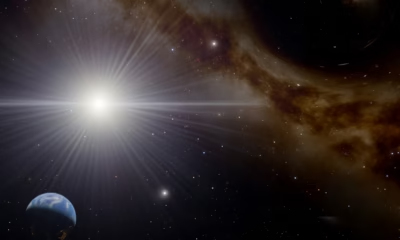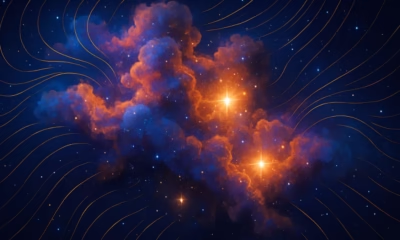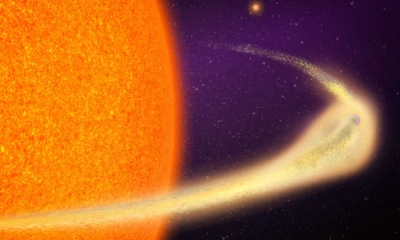Know The Scientist
Dr. Nikku Madhusudhan Brings Us Closer to Finding Life Beyond Earth
Dr. Madhusudhan, a leading Indian-British astrophysicist at the University of Cambridge, has long been on the frontlines of the search for extraterrestrial life

Somewhere in the vast, cold dark of the cosmos, a planet orbits a distant star. It’s not a place you’d expect to find life—but if Dr. Nikku Madhusudhan is right, that assumption may soon be history.
Dr. Madhusudhan, a leading Indian-British astrophysicist at the University of Cambridge, has long been on the frontlines of the search for extraterrestrial life or what we call the alien life. This month, his team made headlines around the world after revealing what could be the strongest evidence yet of life beyond Earth—on a distant exoplanet known as K2-18b.
Using data from NASA’s James Webb Space Telescope, Madhusudhan and his collaborators detected atmospheric signatures of molecules commonly associated with biological processes on Earth—specifically, gases produced by marine phytoplankton and certain bacteria. Their analysis suggests a staggering 99.7% probability that these molecules could be linked to living organisms.
“This marked the first detection of carbon-bearing molecules in the atmosphere of an exoplanet located within the habitable zone,” the University of Cambridge said in a press statement. “The findings align with theoretical models of a ‘Hycean’ planet — a potentially habitable, ocean-covered world enveloped by a hydrogen-rich atmosphere.”
Born in India, Dr. Madhusudhan began his journey in science with an engineering degree from IIT (BHU) Varanasi
In addition, a fainter signal suggested there could be other unexplained processes occurring on K2-18b. “We didn’t know for sure whether the signal we saw last time was due to DMS, but just the hint of it was exciting enough for us to have another look with JWST using a different instrument,” said Professor Nikku Madhusudhan in a news report released by the University of Cambridge.
The man behind the mission
Born in India, Dr. Madhusudhan began his journey in science with an engineering degree from IIT (BHU) Varanasi. But it was during his time at the Massachusetts Institute of Technology (MIT), under the mentorship of exoplanet pioneer Prof. Sara Seager, that he found his calling. His doctoral work—developing methods to retrieve data from exoplanet atmospheres—would go on to form the backbone of much of today’s planetary climate modeling.
Now a professor at the University of Cambridge’s Institute of Astronomy, Madhusudhan leads research that straddles the line between science fiction and frontier science.
A Universe of Firsts
Over the years, his work has broken new ground in our understanding of alien worlds. He was among the first to suggest the concept of “Hycean planets”—oceans of liquid water beneath hydrogen-rich atmospheres, conditions which may be ideal for life. He also led the detection of titanium oxide in the atmosphere of WASP-19b and pioneered studies of K2-18b, the same exoplanet now back in the spotlight.
His team’s recent findings on K2-18b may be the closest humanity has ever come to detecting life elsewhere in the universe.
Accolades and impact
Madhusudhan’s contributions have earned him global recognition. He received the prestigious IUPAP Young Scientist Medal in 2016 and the MERAC Prize in Theoretical Astrophysics in 2019. In 2014, the Astronomical Society of India awarded him the Vainu Bappu Gold Medal for outstanding contributions to astrophysics by a scientist under 35.
But for Madhusudhan, the real reward lies in the questions that remain unanswered.
Looking ahead
Madhusudhan cautions that, while the findings are promising, more data is needed before drawing conclusions about the presence of life on another planet. He remains cautiously optimistic but notes that the observations on K2-18b could also be explained by previously unknown chemical processes. Together with his colleagues, he plans to pursue further theoretical and experimental studies to investigate whether compounds like DMS and DMDS could be produced through non-biological means at the levels currently detected.
Beyond the lab, Madhusudhan remains dedicated to mentoring students and advancing scientific outreach. He’s a firm believer that the next big discovery might come from a student inspired by the stars, just as he once was.
As scientists prepare for the next wave of data and the world watches closely, one thing is clear: thanks to minds like Dr. Nikku Madhusudhan’s, the search for life beyond Earth is no longer a distant dream—it’s a scientific reality within reach.
Know The Scientist
Remembering S.N. Bose, the underrated maestro in quantum physics
Rejected in Britain, celebrated by Einstein, here’s the story of S.N. Bose, the Indian physicist who formulated quantum statistics, now a bedrock theory in condensed matter physics.
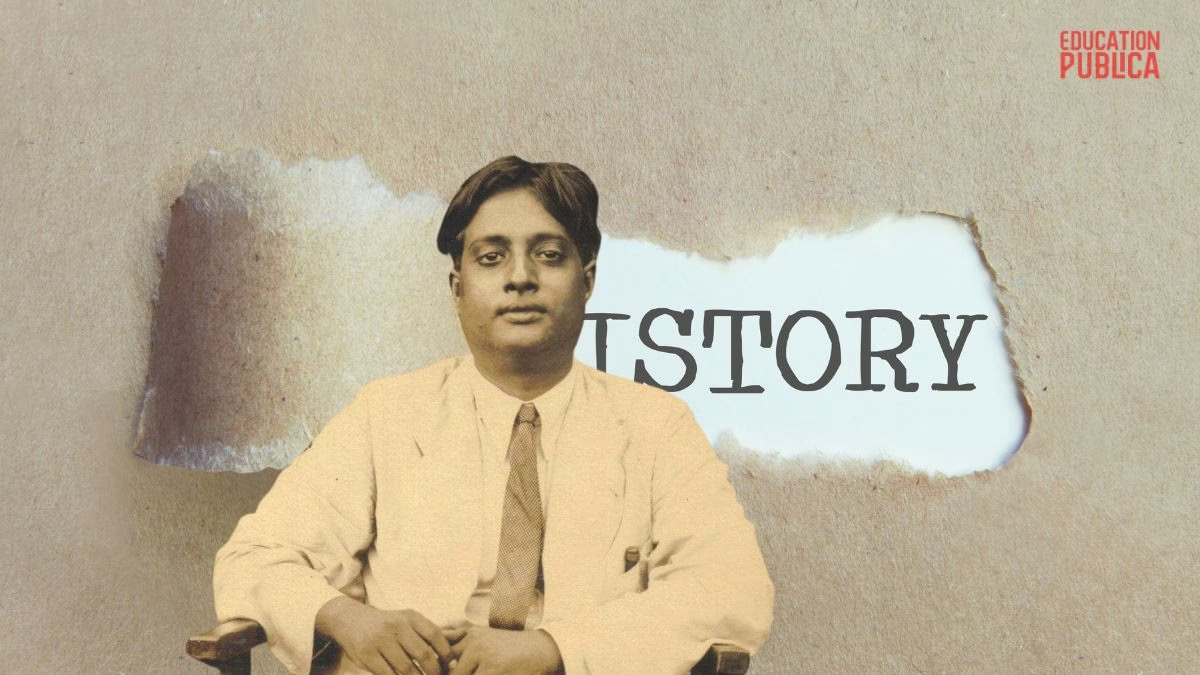
It’s 1924, and Satyendra Nath Bose, going by S.N. Bose was a young physicist teaching in Dhaka, then British India. Grappled by an epiphany, he was desperate to have his solution, fixing a logical inconsistency in Planck’s radiation law, get published. He had his eyes on the British Philosophical Magazine, since word could spread to the leading physicists of the time, most if not all in Europe. But the paper was rejected without any explanations offered.
But he wasn’t going to give up just yet. Unrelenting, he sent another sealed envelope with his draft and this time a cover letter again, to Europe. One can imagine months later, Bose breathing out a sigh of relief when he finally got a positive response – from none other than the great man of physics himself – Albert Einstein.
In some ways, Bose and Einstein were similar. Both had no PhDs when they wrote their treatises that brought them into limelight. And Einstein introduced E=mc2 derived from special relativity with little fanfare, so did Bose who didn’t secure a publisher with his groundbreaking work that invented quantum statistics. He produced a novel derivation of the Planck radiation law, from the first principles of quantum theory.
This was a well-known problem that had plagued physicists since Max Planck, the father of quantum physics himself. Einstein himself had struggled time and again, to only have never resolved the problem. But Bose did, and too nonchalantly with a simple derivation from first principles grounded in quantum theory. For those who know some quantum theory, I’m referring to Bose’s profound recognition that the Maxwell-Boltzmann distribution that holds true for ideal gasses, fails for quantum particles. A technical treatment of the problem would reveal that photons, that are particles of light with the same energy and polarization, are indistinguishable from each other, as a result of the Pauli exclusion principle and Heisenberg’s uncertainty principle.
Fascinated and moved by what he read, Einstein was magnanimous enough to have Bose’s paper translated in German and published in the journal, Zeitschrift für Physik in Germany the same year. It would be the beginning of a brief, but productive professional collaboration between the two theoretical physicists, that would just open the doors to the quantum world much wider. Fascinatingly, last July marked the 100 years since Einstein submitted Bose’s paper, “Planck’s law and the quantum hypothesis” on his behalf to Zeitschrift fur Physik.
With the benefit of hindsight, Bose’s work was really nothing short of revolutionary for its time. However, a Nobel Committee member, the Swedish Oskar Klein – and theoretical physicist of repute – deemed it a mere advance in applied sciences, rather than a major conceptual advance. With hindsight again, it’s a known fact that Nobel Prizes are handed in for quantum jumps in technical advancements more than ever before. In fact, the 2001 Nobel Prize in Physics went to Carl Wieman, Eric Allin Cornell, and Wolfgang Ketterle for synthesizing the Bose-Einstein condensate, a prediction made actually by Einstein based on Bose’s new statistics. These condensates are created when atoms are cooled to near absolute zero temperature, thus attaining the quantum ground state. Atoms at this state possess some residual energy, or zero-point energy, marking a macroscopic phase transition much like a fourth state of matter in its own right.
Such were the changing times that Bose’s work received much attention gradually. To Bose himself, he was fine without a Nobel, saying, “I have got all the recognition I deserve”. A modest character and gentleman, he resonates a lot with the mental image of a scientist who’s a servant to the scientific discipline itself.
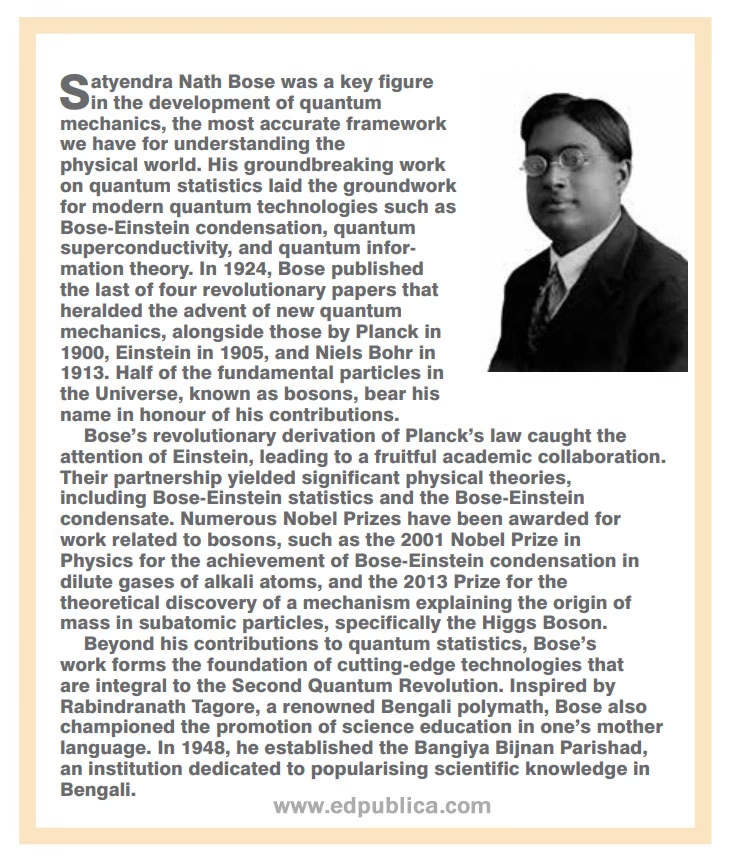
But what’s more upsetting is that, Bose is still a bit of a stranger in India, where he was born and lived. He studied physics at the Presidency College, Calcutta under the tutelage that saw other great Indian physicists, including Jagdish Chandra Bose and Meghnad Saha. He was awarded the Padma Vibhushan, the highest civilian award by the Government of India in 1954. Institutes have been named in his honour, but despite this, his reputation has little if no mention at all in public discourse.
To his physicists’ peers in his generation and beyond, he was recognized in scientific lexicology. Paul Dirac, the British physicist coined the name ‘bosons’ in Bose’s honor (‘bose-on’). These refer to quantum particles including photons and others with integer quantum spins, a formulation that arose only because of Bose’s invention of quantum statistics. In fact, the media popular, ‘god particle’, the Higgs boson, carries a bit of Bose as much as it does of Peter Higgs who shared the 2013 Nobel Prize in Physics with Francois Euglert for producing the hypothesis.
Know The Scientist
Narlikar – the rare Indian scientist who penned short stories
Jayant Narlikar has been one of the most prolific scientists, and science communicators India has ever produced. The octogenarian had died at his residence in Pune.

Jayant Narlikar passed away at his Pune residence on Tuesday. He was 86-years old, and had been diagnosed with cancer. With his demise, India lost a prolific scientist, writer, and institution builder.
In 2004, the government of India had honored Narlikar with the Padma Vibhushan, the second-highest civilian award, for his services to science and society. But that was not his first recognition from the Indian government. At the age of 26, he had received his first Padma Bhushan, in recognition for his work in cosmology, studying the universe’s large-scale structures. He helped contribute to derive Einstein’s field equations of gravity from a more general theory. That work, dubbed the Narlikar-Hoyle theory of gravity, was borne out a collaboration with Narlikar’s doctoral degree supervisor at Cambridge; Fred Hoyle, the then leading astrophysicist of his time.
Narlikar and the steady-state theory
Narlikar and Hoyle bonded over a shared skepticism towards the prevalent Big Bang hypothesis, which sought to extrapolate the universe’s ongoing expansion to its birth at some finite time in the past. However, Narlikar and Hoyle could not have been more opposed, mostly out of their own philosophical beliefs. They drew upon the works of 19th century Austrian physicist and philosopher, Ernest Mach, in rejecting a theory discussing the universe’s beginning in the absence of a reference frame. As such, Narlikar was a strong proponent of Hoyle’s steady-state model of the universe, in which the universe is infinite in extent, and indefinitely old. As such, the steady-state theorists explained away the universe’s expansion to matter being spawned into existence from this vacuum at every instant, aka a C-field.
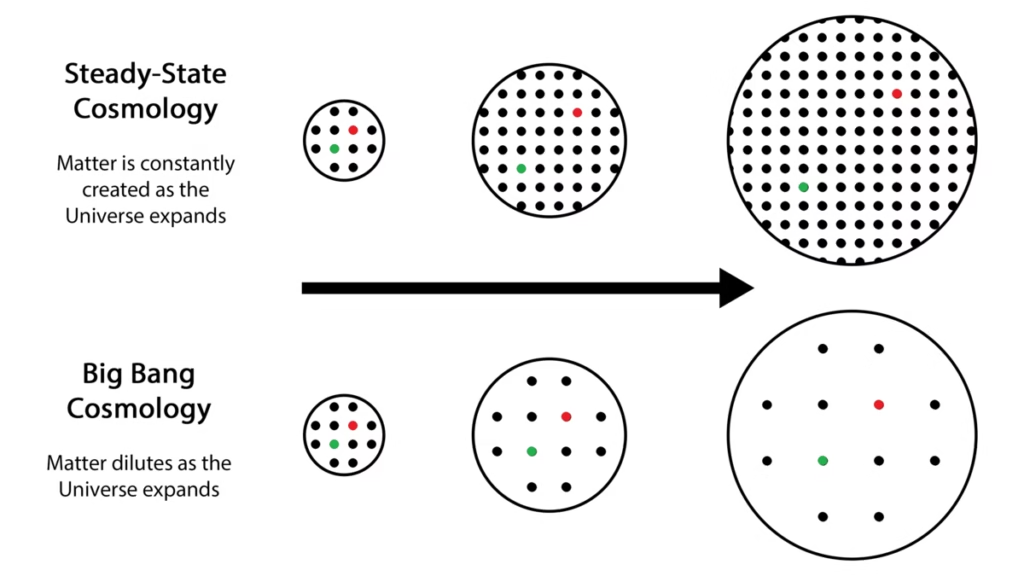
However, the steady-state’s predictions did not hold up in face of evidence the universe expands over time. Nor did its successive avatar, the quasi-steady state theory devised sway scientific consensus. The death knell came when evidence of the cosmic microwave background (aka the CMB) was discovered in 1964.
Despite steady-state’s failure, it provided healthy rivalry to the Big Bang from the 1940s to the 60s, providing opportunities for astronomers to compare observations to precise predictions. In the words of the Nobel laureate Steven Weinberg, “In a sense, this disagreement is a credit to the model; alone among all cosmologies, the steady state model makes such definite predictions that it can be disproved even with the limited observational evidence at our disposal.”
The Kalinga winning short-story writer
Narlikar was more than just a cosmologist, studying the large-scale structure of the universe. He also had been an acclaimed science fiction writer, with his works penned in English, Hindi, and in his vernacular, Marathi. His famous work was a short-story, Dhoomekethu (The Comet), revolving around themes of superstition, faith, rational and scientific thinking. Published in Marathi in 1976, with translations available in Hindi, the story was adapted later into a two-hour film bearing the same name. In 1985, the film aired on the state-owned television broadcasting channels, Doordarshan.
In a way, he was India’s Carl Sagan, airing episodes explaining astronomical concepts, with children being his target audience. The seventeen-episode show, Brahmand (The Universe), aired in 1994, to popular acclaim. One of his most popular books, Akashashi Jadle Nathe (Sky-Rooted Relationship), remains popular. An e-book version in Hindi is available on Goodreads, with 470 reviewers lending an average rating of 4.7 out of 5.
His efforts was honored with an international prize. In 1996, he received the much-coveted Kalinga Prize for the Popularization of Science, awarded annually in India by the United Nations Educational, Scientific and Cultural Organization (UNESCO), “in recognition of his efforts to popularize science through print and electronic media.” Narlikar had been only the second Indian at the time, after the popular science writer Jagjit Singh, to have received the award.
When Narlikar returned to India, accepting a position at the Tata Institute of Fundamental Research (TIFR), he realized that the fruits of astrophysical research did not flourish outside central institutions. Though Bengaluru had an Indian Institute of Astrophysics, Narlikar envisioned basing a research culture paralleling his time at Cambridge. Hence, the Inter-University Centre for Astronomy and Astrophysics (IUCAA) was born in 1988, and Narlikar was appointed its founding director. Arguably, his most visible legacy would have been to shape India’s astrophysical research culture through his work with the IUCAA (pronounced “eye-you-ka”).
Know The Scientist
Mysterious, resilient, and radiant: The timeless legacy of Marie Curie
A scientist in her own right, a symbol of resilience, and a martyr to science—Marie Curie’s life was as radioactive as her path-breaking discoveries

Science is not only a pursuit of knowledge, but a passion that can consume a life—sometimes even the very body of its creator. This is the dramatic tale of one such life, the life of Marie Curie, whose pioneering contributions to science forever altered the course of history.
Marie Curie, a name synonymous with perseverance and scientific brilliance, lived and died for science, transforming the world with her discoveries. Her life was one of constant struggle against societal norms, poverty, and personal loss, yet she rose to become one of the most celebrated scientists in history—earning two Nobel Prizes, in two different fields, in a time when women were largely excluded from the scientific community. Her relentless pursuit of knowledge, and the cost at which she achieved it, continues to inspire generations of scientists.

The Struggles of a Childhood
Born Maria Salomea Skłodowska on November 7, 1867, in Warsaw, Poland—then under Russian rule—Marie came from a family of educators who instilled in her a love for learning. However, her early life was filled with hardship. At just nine years old, she lost her sister, and at eleven, her mother passed away from tuberculosis. These tragic losses shaped her character, leading her to abandon her Christian faith and fueling her desire to escape the constraints of her environment through education.
In a country where higher education was largely inaccessible to women, Marie defied all odds. She secretly studied at the “Flying University,” a clandestine institution offering advanced learning despite the Russian occupation. After years of financial hardship and personal sacrifice, she moved to Paris in 1891 to attend the Sorbonne (University of Paris), where she earned degrees in physics, chemistry, and mathematics.
The Meeting of Minds: Pierre Curie
It was in Paris that Marie met Pierre Curie, a brilliant physicist whose work on magnetism and crystallography was already well known. Their intellectual partnership quickly blossomed into a romantic one. In 1895, they married, and together they embarked on cutting-edge research in radioactivity, a term that Marie herself coined.

Though their early years were marked by financial difficulties—Marie sometimes had to work as a governess to support her research—the couple’s scientific collaborations were prodigious. In 1898, they discovered the elements Polonium (named after Marie’s homeland, Poland) and Radium, forever altering the landscape of chemistry and physics.
A Breakthrough: Radioactivity
Their work was transformative. While investigating the properties of uranium, the Curies discovered that certain materials emitted a form of energy that could penetrate matter. This discovery laid the foundation for the study of radioactivity. Marie Curie’s research, however, was far from simple theory. She showed that uranium’s radioactivity was intrinsic to the atom, a revolutionary insight that led to the birth of atomic physics.
In 1903, Marie and Pierre Curie, along with Henri Becquerel, were awarded the Nobel Prize in Physics for their pioneering work in radioactivity. It was an extraordinary achievement, and Marie became the first woman ever to receive a Nobel Prize. This historic honour, however, was only the beginning.
Personal Tragedy and Triumph
Marie’s life, though marked by scientific triumph, was also filled with personal tragedy. In 1906, just three years after receiving the Nobel Prize, Pierre Curie was tragically killed in a street accident. His death left Marie devastated, but her resilience was remarkable. She took over his position as a professor at the Sorbonne, becoming the first woman to hold such a post at the prestigious university.

Marie’s drive and determination did not wane in the face of personal loss. In 1911, she was awarded the Nobel Prize in Chemistry for her work in isolating pure radium and polonium, making her the first person—and remains the only woman—to win Nobel Prizes in two different scientific fields. Her acceptance speech, in which she credited her late husband Pierre, moved many to tears.
The War Effort and Her Legacy

As the First World War broke out in 1914, Marie’s scientific genius took on a new form. Understanding the importance of radiology in medicine, she took her research to the battlefield. With the help of her colleagues, Marie developed mobile X-ray units—called “Little Curies”—which she personally drove to the front lines to assist in diagnosing injuries. Her efforts saved countless lives, and during the war, more than a million soldiers received X-ray examinations due to her work.
Despite her scientific fame, Marie’s health began to deteriorate due to her constant exposure to radioactive materials. The very substances she had spent her life researching were slowly poisoning her. In 1934, Marie Curie passed away from aplastic anemia, a disease caused by the prolonged exposure to radiation.
The Aftermath of Her Discoveries
In an odd twist, the very radioactive materials that made Marie Curie famous also played a role in her untimely death. Her personal belongings, including books, notes, and even her clothing, remained highly radioactive long after her death. In fact, her laboratory notebooks, now preserved in Paris, are still radioactive today—scientists must wear protective gear to handle them.

The legacy of Marie Curie, however, is far more than the danger of radiation. Her work laid the groundwork for cancer treatments, nuclear energy, and the development of atomic weapons. Yet, Curie herself was deeply committed to the idea that scientific discoveries should be used for the benefit of humanity, not destruction. During her life, she was adamant that the energy she discovered could and should be used to improve health and welfare, not war.
A Family Legacy of Science
Marie’s daughters, Irène and Ève, carried on the family legacy of scientific achievement. Irène, like her mother and father, went on to win the Nobel Prize in Chemistry in 1935 for her work on radioactivity, making the Curies one of the few families to have produced multiple Nobel laureates. Irène’s own life, unfortunately, was similarly marked by tragedy, as she, too, suffered from leukemia—a consequence of the radiation exposure passed down through the family.
While Ève, the younger daughter, pursued a career in writing and journalism, it was the scientific legacy of her parents that endured. Today, the Curie family’s contributions to science continue to be honored worldwide.
The Legacy That Lives On
In today’s world, the impact of Marie Curie’s work is felt across many disciplines. The very essence of nuclear science, from energy generation to medical diagnostics, is built on the foundation that she and her husband established. The applications of her discoveries are so widespread that it’s impossible to escape their relevance. From life-saving cancer treatments using radium and radiation therapy to modern-day technologies such as X-rays and PET scans, Curie’s discoveries have directly influenced these advancements.

In an age where scientific innovation continues to transform society, Marie Curie’s life serves as a reminder of the sacrifices scientists make in pursuit of knowledge. Her resilience, determination, and focus on contributing to the greater good are attributes that resonate deeply in today’s world of rapid technological change and the constant battle against existential global challenges like climate change, energy crises, and health pandemics. The courage to ask difficult questions, confront the unknown, and risk everything for the betterment of humanity is something that continues to inspire not just scientists but anyone who seeks to push the boundaries of what is possible.
Her story also speaks to the ongoing fight for gender equality in science. Despite the significant strides made toward inclusivity, women remain underrepresented in scientific fields, particularly in leadership roles. Marie Curie’s legacy reminds us of the importance of diversity in innovation and the need to break down barriers to ensure that talent, regardless of gender, is nurtured and celebrated.

Curie’s life has transcended time and continues to inspire, even in the 21st century. The 2019 biographical film Radioactive, based on her life, brought her story to a new generation, exploring not just her scientific achievements but also the personal struggles and sacrifices she made. The film serves as a testament to the complexities of her legacy—both as a scientist who reshaped the future and as a woman who defied societal norms to do so.
A Life That Still Glows
Marie Curie’s contributions to science were not just about discovering new elements or phenomena; they were about changing the way humanity understood the world. She unlocked the mysteries of the atom and laid the groundwork for technologies that are still saving lives today. She did so at great personal cost, but her story is not just one of sacrifice—it’s one of triumph, resilience, and an unwavering dedication to science.
Even now, decades after her death, Marie Curie’s discoveries continue to illuminate the way forward in fields like medicine, energy, and environmental science. Her life reminds us that science is not just about the lab or the classroom; it is about the real-world impact that research can have on improving human lives and addressing global challenges.
References:
1. Curie, M. (1923). Pierre Curie (Autobiography).
2. “Marie Curie: A Biography” by Susan Quinn. (1995).
3. Marie Curie (2019) directed by Marjane Satrapi.
4. “Radium and Its Applications in Medicine: The Legacy of Marie Curie” by Francesca Rossi. (Journal of Nuclear Medicine, 2012).
5. The Life and Legacy of Marie Curie by Rosalind P. Williams. (Oxford University Press, 2009).
-

 Space & Physics5 months ago
Space & Physics5 months agoIs Time Travel Possible? Exploring the Science Behind the Concept
-

 Earth6 months ago
Earth6 months ago122 Forests, 3.2 Million Trees: How One Man Built the World’s Largest Miyawaki Forest
-

 Space & Physics6 months ago
Space & Physics6 months agoDid JWST detect “signs of life” in an alien planet?
-

 Know The Scientist5 months ago
Know The Scientist5 months agoNarlikar – the rare Indian scientist who penned short stories
-

 Society4 months ago
Society4 months agoShukla is now India’s first astronaut in decades to visit outer space
-

 Society4 months ago
Society4 months agoAxiom-4 will see an Indian astronaut depart for outer space after 41 years
-

 Earth4 months ago
Earth4 months agoWorld Environment Day 2025: “Beating plastic pollution”
-

 Society6 months ago
Society6 months agoRabies, Bites, and Policy Gaps: One Woman’s Humane Fight for Kerala’s Stray Dogs

